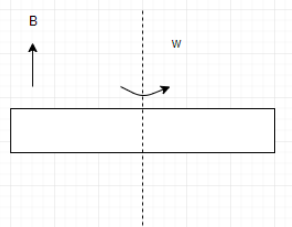
A conducting rod of length 2l is rotating with constant angular speed $w$ about its perpendicular bisector. A uniform magnetic field B exists parallel to the axis of rotation. the emf induced between two ends of the rods is: -

A. $Bw{{l}^{2}}$
B. $\dfrac{Bw{{l}^{2}}}{2}$
C. $\dfrac{Bw{{l}^{2}}}{8}$
D. zero

Answer
549.6k+ views
Hint: We are given a rod of length 2L which is rotating with an angular speed $w$. The axis of rotation passes through the geometrical centre of the rod or we can say it is rotating about an axis passing through the centre of mass of the rod and is perpendicular to it. There exist a magnetic field and as such magnetic flux. We know when the flux changes then an induced emf is produced.
Complete step by step answer:
Let us consider a small element dx at a distance x from the centre of the rod rotating with angular velocity $w$ about its perpendicular bisector. The emf induced in the small element due to its motion is given by:\[~~~de\text{ }=B\omega xdx\]
So, to find the net induced emf, we integrate the above equation within the proper limits. Let us find emf induced between the centre of the rod and one of its side is, so the limit extends from,
$~~~\int\limits_{0}^{e}{de}\text{ }=\int\limits_{0}^{l}{B\omega xdx}$
$\Rightarrow e=Bw[\dfrac{{{x}^{2}}}{2}]_{0}^{l}$
$\therefore e=\dfrac{Bw{{l}^{2}}}{2}$
This is the emf induced in the rod from left end to the centre of the rod. And if we find the emf induced from the right end to the centre of the rod then the emf will come out to be the same but the polarity will be opposite. So net emf induced will eventually come out to be zero.
So, the correct option is D.
Note: We know from maxwell equations that a changing magnetic field can induce current whose direction is given by Lenz law. Also, if the magnetic flux remains constant then there will be no induced emf. If there was no change in the magnetic flux then there would have been no emf induced in the conductor. Since flux is the dot product of magnetic field and area vector, to change the flux there can be three conditions:
1. Change in a magnetic field
2. Change in area of conductor
3. Change in the angle between the magnetic field and the area vector.
Complete step by step answer:
Let us consider a small element dx at a distance x from the centre of the rod rotating with angular velocity $w$ about its perpendicular bisector. The emf induced in the small element due to its motion is given by:\[~~~de\text{ }=B\omega xdx\]
So, to find the net induced emf, we integrate the above equation within the proper limits. Let us find emf induced between the centre of the rod and one of its side is, so the limit extends from,
$~~~\int\limits_{0}^{e}{de}\text{ }=\int\limits_{0}^{l}{B\omega xdx}$
$\Rightarrow e=Bw[\dfrac{{{x}^{2}}}{2}]_{0}^{l}$
$\therefore e=\dfrac{Bw{{l}^{2}}}{2}$
This is the emf induced in the rod from left end to the centre of the rod. And if we find the emf induced from the right end to the centre of the rod then the emf will come out to be the same but the polarity will be opposite. So net emf induced will eventually come out to be zero.
So, the correct option is D.
Note: We know from maxwell equations that a changing magnetic field can induce current whose direction is given by Lenz law. Also, if the magnetic flux remains constant then there will be no induced emf. If there was no change in the magnetic flux then there would have been no emf induced in the conductor. Since flux is the dot product of magnetic field and area vector, to change the flux there can be three conditions:
1. Change in a magnetic field
2. Change in area of conductor
3. Change in the angle between the magnetic field and the area vector.
Recently Updated Pages
Master Class 12 English: Engaging Questions & Answers for Success

Master Class 12 Business Studies: Engaging Questions & Answers for Success

Master Class 12 Economics: Engaging Questions & Answers for Success

Master Class 12 Social Science: Engaging Questions & Answers for Success

Master Class 12 Maths: Engaging Questions & Answers for Success

Master Class 12 Chemistry: Engaging Questions & Answers for Success

Trending doubts
What are the major means of transport Explain each class 12 social science CBSE

Which are the Top 10 Largest Countries of the World?

Draw a labelled sketch of the human eye class 12 physics CBSE

Explain sex determination in humans with line diag class 12 biology CBSE

The pH of the pancreatic juice is A 64 B 86 C 120 D class 12 biology CBSE

Explain sex determination in humans with the help of class 12 biology CBSE




